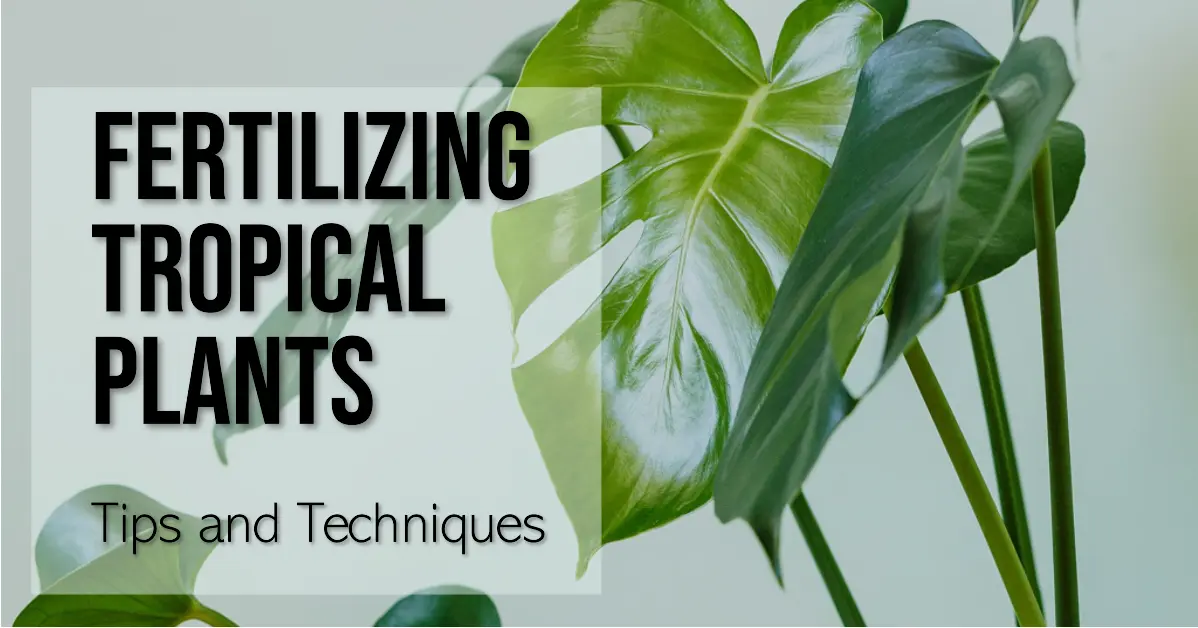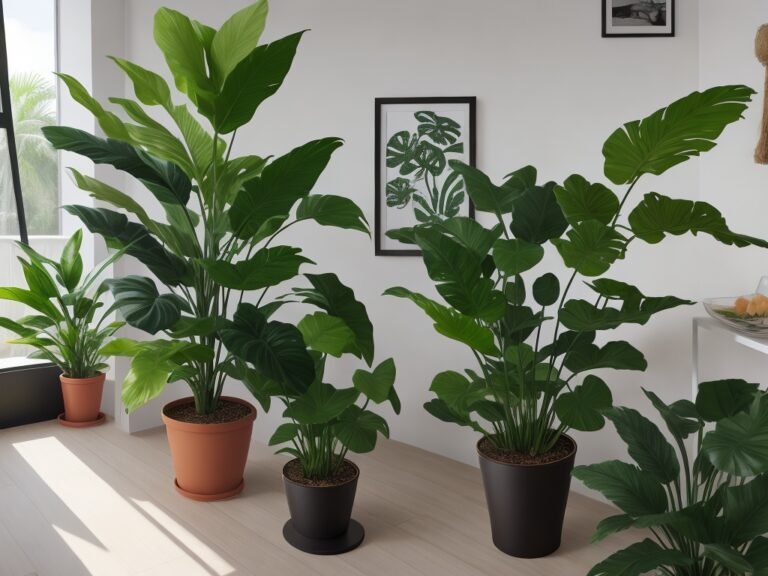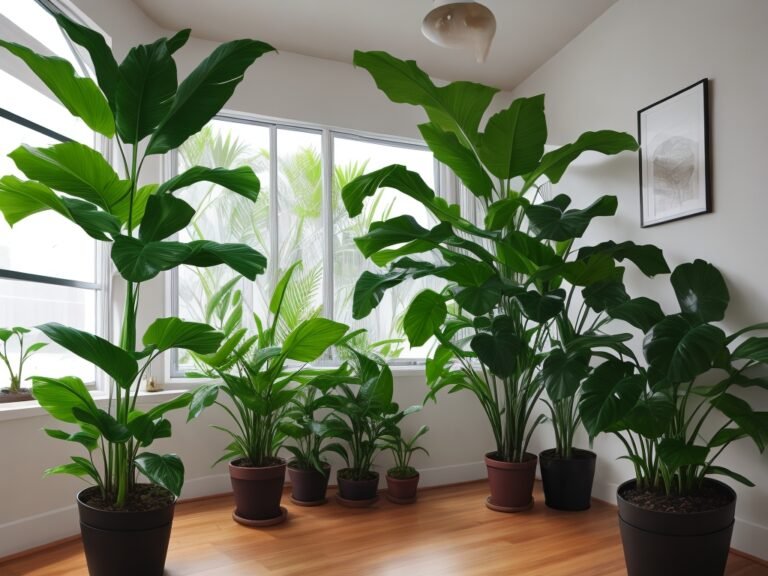Fertilizing Tropical Plants: Tips and Techniques
Fertilizing Tropical Plants: Your Ultimate Guide
Nourishing those vibrant leaves and blossoms boils down to one pivotal garden practice – fertilizing tropical plants. Whether venturing into gardening or being a seasoned enthusiast, understanding fertilizing nuances can be your golden ticket to a breathtaking tropical haven. Let’s delve deep into fertilizing tropical plants for vibrant results.
Understanding the Unique Needs of Tropical Plants
When the focal point is fertilizing tropical plants, a knowledge foundation on their unique requirements is a game-changer.
These lush beauties demand warm, humid habitats, and to truly thrive, understanding the soil type, the nutrient palette they crave, and the precise fertilizers to cater to these needs is indispensable.
Key Insights:
- A deep understanding of your tropical plants is the cornerstone for successful fertilization.
- The art and science of selecting and applying fertilizers can dictate the health and vibrancy of your plants.
- Regular fertilization and stellar maintenance ensure a garden that’s not just thriving but absolutely dazzling.
Fertilizing Tropical Plants with Precision
Tropical plants are revered in the world of lush greens and vibrant colors. Their versatility makes them a favorite for both indoor and outdoor green spaces. Hence, the act of fertilizing tropical plants is a topic every green thumb is keen on mastering.
A nitrogen-rich fertilizer is your go-to choice when fertilizing tropical plants to foster leaf growth. This preference stems from their predominant foliage growth pattern.
Brand Tip: Always choose a fertilizer brand that resonates with quality and efficacy, ensuring it is crafted for tropical plants with a high nitrogen content coupled with essential nutrients such as phosphorus and potassium.
A Guide to Soil and Drainage When Fertilizing Tropical Plants
Now, let’s touch upon two significant pillars when fertilizing tropical plants – soil and drainage. They hold the reins to the nutrient and moisture highway for these plants.
Soil Mix Recipe for Tropical Plants:
- Equal parts potting soil, perlite or vermiculite, and coarse sand
- pH level: Slightly acidic, between 5.5 and 6.5
- Regular pH testing to ensure optimum nutrient absorption
Drainage Essentials:
- Pots equipped with drainage holes
- A foundational layer of gravel or sand for excellent water management
Note: Ensuring soil and drainage harmony can be a process of fine-tuning. But with attention and patience, you’re paving the way for your tropical plants to reach their zenith.
Final Thoughts
Fertilizing tropical plants is indeed an art intertwined with science. As you step into this nurturing journey, remember that understanding their innate needs and marrying them with the right fertilizer choice can unfold a tropical paradise in your own living space. Embrace the process, witness the growth, and be ready for a tropical spectacle that’s nothing short of magic.
Master Guide to Fertilizing Tropical Plants
Boost the health, vibrancy, and yield of your tropical plants through the art of fertilization. Here’s everything you need to know.
Understanding the Essence of Fertilizing Tropical Plants
Fertilizing tropical plants isn’t just a task. It’s a vital step in your gardening process that ushers your plants into a vibrant and resilient life.
It’s a straightforward process: as they grow, plants exhaust the nutrients available in the soil. Fertilization replenishes these crucial elements, fueling further growth. But fertilizing isn’t just about growth; it aids in creating a plant robust enough to resist pests and diseases while encouraging a higher yield of flowers, fruits, and leaves.
Choosing the right fertilizer and applying it correctly cannot be emphasized enough. Too little or too much can be detrimental. Striking a balance is key.
Takeaways:
- Growth: Fertilizers support healthy growth, pushing plants to reach their full potential.
- Resistance: Healthy plants can ward off pests and diseases more effectively.
- Recovery: A well-fertilized plant can recover from environmental damage with greater ease.
A Look at Different Types of Fertilizers for Tropical Plants
When it comes to fertilizing your tropical sanctuary, the variety of fertilizers available can be slightly overwhelming. Here’s a breakdown to help you navigate your options:
Granular Fertilizer
- Slow-release
- Available in organic and commercial varieties
- Ideal for sustained nutrient supply
Liquid Fertilizer
- Fast-acting
- Easy application and rapid absorption
- Available in organic and commercial varieties
Slow-release Fertilizer
- Extended nutrient release period
- Available in granular and liquid forms
- Less frequent applications required
Controlled-release Fertilizer
- Slow and even nutrient release
- Ensures steady nutrient supply
- Available in granular and liquid forms
Organic Fertilizer
- Derived from natural materials like compost and bone meal
- Slow-release
- Avoids synthetic materials
Commercial Fertilizer
- Synthetic composition
- Fast-acting with immediate nutrient boost
- Specific nutrient balance
Brand Specific: Osmocote
- Controlled-release fertilizer
- Slow, even extended nutrient release
- Available in granular and liquid forms
Delving into the Essential Nutrients
To master the art of fertilizing tropical plants, understanding the essential nutrients is pivotal. Here, we detail the critical nutrients necessary for your plants:
| Nutrient | Role | Deficiency Symptoms |
|---|---|---|
| Nitrogen | Vital for photosynthesis and chlorophyll production | Stunted growth, yellowing leaves, poor flowering |
| Phosphorus | Promotes root development and flower production | Weak stems, poor root development |
| Potassium | Enhances stress tolerance and disease resistance | Weak stems, poor flowering |
| Iron | Crucial in photosynthesis | Yellowing leaves, stunted growth |
| Magnesium | Facilitates enzyme activation and energy transfer | Yellow leaves, stunted growth |
| Calcium | Vital for cell wall formation and root development | Poor root development, susceptibility to diseases |
In addition to the primary nutrients, tropical plants also require minor elements such as zinc, copper, manganese, boron, sulfur, and others, albeit in smaller quantities.
In Summary
Fertilizing tropical plants is a rewarding endeavor that nourishes your plants, paving the way for a garden teeming with life, color, and astounding growth. Remember, the right balance of nutrients and a perfect fertilizer type can work wonders for your tropical oasis. Choose wisely, and watch your tropical paradise flourish.
Fertilizing Different Tropical Plants
When it comes to fertilizing tropical plants, it’s important to keep in mind that different plants have different needs. Here are some guidelines for fertilizing some popular tropical plants:
Orchids
Orchids are popular tropical plants that require a special type of fertilizer. Look for a fertilizer that is specifically formulated for orchids, as they have unique nutritional needs. Orchids typically need to be fertilized every two weeks during the growing season and once a month during the dormant season.
Palms
Palms are another popular tropical plant that requires a specific type of fertilizer. Look for a palm fertilizer that contains a balance of nitrogen, phosphorus, and potassium. Palms should be fertilized every three months during the growing season.
Houseplants
Most tropical houseplants can be fertilized with a balanced fertilizer suited for potted plants. Look for a fertilizer with an NPK ratio of 9-4-9, 10-10-10, 20-10-20, or 20-20-20. Houseplants should be fertilized every two weeks during the growing season and once a month during the dormant season.
Hibiscus
Hibiscus plants require a frequent, light application of balanced fertilizer. Look for a fertilizer with an NPK ratio of 10-10-10 or 20-20-20. Hibiscus plants should be fertilized every two weeks during the growing season and once a month during the dormant season.
Air Plants
Air plants, also known as Tillandsia, can be fertilized with a balanced fertilizer suited for potted plants. Look for a fertilizer with an NPK ratio of 9-4-9, 10-10-10, 20-10-20, or 20-20-20. Air plants should be fertilized every two weeks during the growing season and once a month during the dormant season.
Gardenias
Gardenias require a frequent, light application of balanced fertilizer. Look for a fertilizer with an NPK ratio of 10-10-10 or 20-20-20. Gardenias should be fertilized every two weeks during the growing season and once a month during the dormant season.
Bromeliads
Bromeliads can be fertilized with a balanced fertilizer suited for potted plants or fish emulsion. Look for a fertilizer with an NPK ratio of 9-4-9, 10-10-10, 20-10-20, or 20-20-20. Bromeliads should be fertilized every two weeks during the growing season and once a month during the dormant season.
Staghorn Ferns
Staghorn ferns can be fertilized with a balanced fertilizer suited for potted plants or fish emulsion. Look for a fertilizer with an NPK ratio of 9-4-9, 10-10-10, 20-10-20, or 20-20-20. Staghorn ferns should be fertilized every two weeks during the growing season and once a month during the dormant season.
Ixoras
Ixoras require a frequent, light application of balanced fertilizer. Look for a fertilizer with an NPK ratio of 10-10-10 or 20-20-20. Ixoras should be fertilized every two weeks during the growing season and once a month during the dormant season.
Remember to always follow the instructions on the fertilizer packaging, and never over-fertilize your plants. With the right fertilizer and proper care, your tropical plants will thrive.
Fertilizing Techniques
When it comes to fertilizing tropical plants, there are a few key techniques to keep in mind. First and foremost, choosing the right fertilizer for your specific plant is important. Look for a balanced NPK ratio fertilizer, such as 10-10-10 or 20-20-20.
Another important consideration is the method of application. For potted plants, a slow-release fertilizer can be a good option. This type of fertilizer releases nutrients gradually over time, which can help prevent over-fertilization and ensure your plant gets the nutrients it needs.
When applying fertilizer to plants in the ground, it’s important to pay attention to the drip line. This is the area directly beneath the outermost branches of the plant. Applying fertilizer within this area can help ensure that the plant’s roots are able to access the nutrients.
One technique that can be particularly effective for tropical plants is the use of foliar sprays. These sprays are applied directly to the leaves of the plant and can help provide a quick boost of nutrients. However, it’s important to follow the manufacturer’s instructions carefully and avoid overuse, as too much of a foliar spray can be harmful to your plant.
Finally, it’s important to be mindful of the risks of over-fertilization. Applying too much fertilizer can harm your plant, so follow the instructions carefully and avoid overdosing. If you’re unsure how much fertilizer to use, start with a smaller amount and gradually increase as needed.
By choosing the right fertilizer, applying it correctly, and being mindful of the risks of over-fertilization, you can help ensure that your tropical plants get the nutrients they need to thrive.
Seasonal Fertilizing
As a tropical plant enthusiast, I understand the importance of proper fertilization to ensure healthy growth and abundant blooms. One crucial aspect of fertilizing tropical plants is timing. Fertilizing during the right season can significantly affect plant health and vigor.
The growing season for tropical plants usually starts in spring and lasts until early fall. During this time, the plants are actively producing new growth and flowering. Warm weather and increased sunlight provide ideal conditions for plants to absorb nutrients and grow.
I recommend following a regular fertilizer schedule during the growing season to take advantage of these optimal conditions. A balanced fertilizer mix with a nitrogen, phosphorus, and potassium ratio, such as an 8-3-9 mix, is suitable for most tropical plants.
It’s important to note that over-fertilizing can be harmful to tropical plants. I suggest fertilizing every two to four weeks during the growing season, depending on the plant’s needs and the fertilizer’s instructions. Using too much fertilizer can cause excessive foliage growth, weakening the plant and making it more susceptible to pests and diseases.
Weather conditions can also affect fertilizer absorption. During periods of heavy rain, nutrients can leach out of the soil quickly, making it necessary to adjust the fertilizing schedule accordingly. In contrast, it’s essential to water plants adequately during dry spells to ensure proper nutrient uptake.
In summary, timing is crucial when it comes to fertilizing tropical plants. Following a regular fertilizer schedule during the growing season can help ensure healthy growth and abundant blooms. However, avoiding over-fertilizing and adjusting the schedule based on weather conditions is important to ensure optimal nutrient uptake.
Additional Care Tips
When it comes to fertilizing tropical plants, it’s important to remember that fertilizer alone is not enough to keep them healthy. There are several additional care tips that you should keep in mind to ensure that your plants thrive.
First and foremost, make sure your tropical plants are getting the right amount of sunlight. Most tropical plants prefer bright, indirect light, so be sure to place them in a location where they will receive plenty of light but not direct sunlight.
Another important aspect of caring for tropical plants is repotting. As your plants grow, they may outgrow their containers, which can lead to root-bound plants and stunted growth. To avoid this, repot your plants every year or two, depending on their growth rate.
In addition to repotting, keeping your tropical plants well-watered is important. However, be careful not to overwater them, as this can lead to root rot and other problems. Instead, water your plants when the top inch of soil feels dry to the touch.
To help retain moisture and nutrients in the soil, consider adding a layer of mulch or compost to the top of the soil. This will also help prevent weeds from growing and provide a natural source of fertilizer for your plants.
Finally, consider using worm castings as a natural fertilizer for your tropical plants. Worm castings are rich in nutrients and beneficial microorganisms and can help promote healthy growth and strong root systems.
By following these additional care tips, you can help ensure that your tropical plants remain healthy and vibrant for years to come.
Purchasing Fertilizers
When it comes to purchasing fertilizers for tropical plants, there are a few things to keep in mind. As someone who has been gardening for years, I have learned that not all fertilizers are created equal. Here are some tips to help you choose the right fertilizers for your tropical plants.
First, consider where you will be purchasing your fertilizers. You can find fertilizers at nurseries, garden centers, and even online. If you are looking for a wider selection, I recommend checking out a commercial supplier. They often carry a larger variety of fertilizers and can offer bulk discounts.
When choosing a fertilizer, paying attention to the nutrient content is important. Look for a fertilizer that has a balanced NPK (nitrogen, phosphorus, and potassium) ratio, such as 10-10-10 or 20-20-20. You can also find fertilizers specifically formulated for tropical plants, which may have additional micronutrients beneficial for these plants.
It is also important to consider the form of the fertilizer. You can choose from liquid, granular, or slow-release fertilizers. Liquid fertilizers are easy to apply and quickly absorbed by the plants, while granular fertilizers are slower to release and provide a longer-lasting effect. Slow-release fertilizers are designed to release nutrients over an extended period of time, reducing the need for frequent applications.
Don’t be swayed by marketing tactics when it comes to brand names. Instead, focus on the nutrient content and the form of the fertilizer. In fact, sometimes the most expensive bag of an unknown brand can be better than a well-known brand name product.
In summary, when purchasing fertilizers for your tropical plants, consider where you will be purchasing from, the nutrient content, the form of the fertilizer, and don’t be swayed by brand names. Remembering these things, you can choose a fertilizer that will help your tropical plants thrive.
Common Mistakes and Solutions
When it comes to fertilizing tropical plants, there are a few common mistakes that many people make. Here are some of the most common mistakes and solutions:
Over-fertilizing
Over-fertilizing is one of the most common mistakes people make when fertilizing their tropical plants. Over-fertilizing can lead to a buildup of salts in the soil, which can cause root damage and even plant death.
Solution: To avoid over-fertilizing, following the instructions on the fertilizer package is important. Use the recommended amount of fertilizer for your plant and avoid applying more than recommended. You can also flush the soil with water periodically to help remove any excess salts.
Using a dry fertilizer
Another mistake people make is using a dry fertilizer that is not properly mixed with water. This can lead to uneven distribution of nutrients and can cause damage to the roots of your plants.
Solution: To avoid this, always mix your fertilizer with water according to the instructions on the package. This will ensure that the nutrients are evenly distributed and that your plants receive the proper amount of nutrients.
Low nitrogen levels
Tropical plants require a lot of nitrogen to grow and thrive. If your plants are not getting enough nitrogen, they may appear stunted or have yellow leaves.
Solution: To increase nitrogen levels, you can use a high nitrogen fertilizer. Look for a fertilizer with a high first number in the N-P-K ratio (e.g. 10-5-5). You can also add organic matter to the soil, such as compost or manure, which will help increase nitrogen levels naturally.
By avoiding these common mistakes and following the solutions provided, you can ensure that your tropical plants receive the proper amount of nutrients to grow and thrive.
Conclusion
In conclusion, fertilizing tropical plants is crucial for their healthy growth and development. It is important to choose the right type of fertilizer, depending on the plant’s specific needs. Organic fertilizers are a great option for those who want to avoid synthetic chemicals but may not provide all the necessary nutrients.
Timing is also important when fertilizing tropical plants. It is best to fertilize during the growing season, which is usually from spring to fall. Over-fertilizing can be harmful to the plant, so it is important to follow the instructions on the package and avoid applying too much fertilizer.
When applying fertilizer, it is important to avoid getting it on the leaves and stems of the plant, as this can cause damage. Water-soluble fertilizers should be applied more frequently, while slow-release fertilizers can be applied less often.
In addition to fertilizing, it is important to provide the right soil conditions for tropical plants. These plants require well-draining soil that is rich in organic matter. Regular watering and proper drainage are also important for their health.
Overall, fertilizing tropical plants requires some knowledge and care, but it is essential for their successful growth and development. Following the guidelines above can help your tropical plants thrive and create a beautiful and healthy garden.
Frequently Asked Questions
What is the best fertilizer for tropical fruit trees?
For tropical fruit trees, an 8-3-9 mix is a good choice. This mix is formulated for most tropical fruit trees and provides a good balance of nutrients. However, palm enthusiasts may prefer to use Palm Special, an 8-2-12 fertilizer that is specially formulated for palms.
Should you fertilize tropical plants?
Yes, you should fertilize tropical plants to keep them healthy and thriving. Tropical plants require more nutrients than other plants due to their rapid growth and high metabolism.
Is Miracle Grow good for tropical plants?
Miracle Grow is a popular fertilizer that can be used for tropical plants. However, it is important to follow the instructions on the package and not to over-fertilize, as this can damage the plant.
What is the best fertilizer ratio for indoor tropical plants?
A balanced fertilizer with an N-P-K ratio of 20-20-20 for indoor tropical plants is a good choice. This will provide the plant with the nutrients it needs to grow and thrive.
What are some options for liquid fertilizer for tropical plants?
Liquid fertilizers are a convenient option for fertilizing tropical plants. Some good options include fish emulsion, seaweed extract, and compost tea. These fertilizers are rich in nutrients and can be easily absorbed by the plant.
What are some homemade fertilizer options for indoor tropical plants?
Homemade fertilizers can be a great option for indoor tropical plants. Some good options include banana peels, coffee grounds, and eggshells. These items are rich in nutrients and can be easily added to the soil to provide the plant with the nutrients it needs to grow and thrive.







